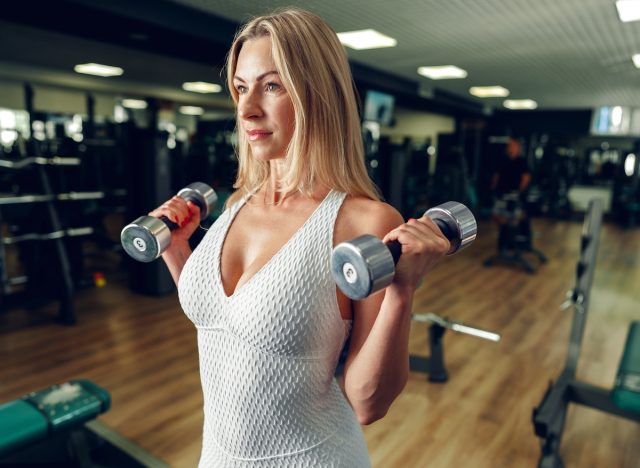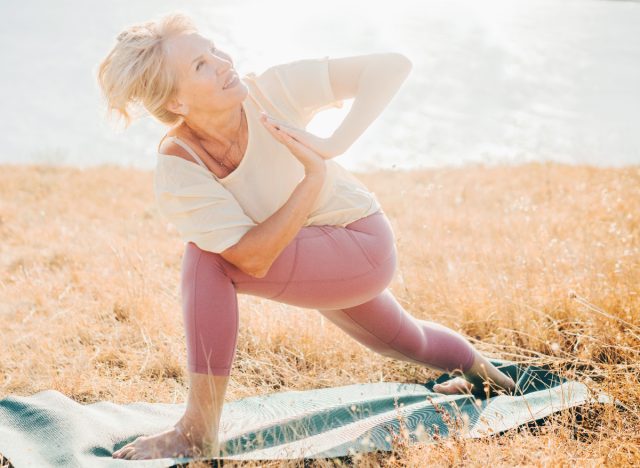In order to boost your heart health, following several healthy lifestyle habits is key, with regular exercise being a prominent one. As a matter of fact, Elizabeth Klodas, MD FACC, a board-certified cardiologist, founder of the Preventative Cardiology Clinic, and the founder and chief medical officer of Step One Foods, dubs exercise “a cornerstone of heart health,” and inactivity “a major risk factor for developing heart disease” (along with dying prematurely due to a variety of diseases, such as dementia and cancer). That’s why we spoke with Dr. Klodas about her go-to exercises for a healthy heart.
But before you lace up your sneakers and test out these exercises yourself, let’s talk a little bit more about why physical activity is so crucial to your heart health and overall wellness. “Exercise helps raise HDL (good cholesterol) while lowering LDL (bad cholesterol),” Dr. Klodas continues to explain. “It helps keep blood pressure well controlled and improves insulin sensitivity so blood sugars are better controlled as well. It helps with calorie balance so we avoid excess weight. Given that abnormal cholesterol, high blood pressure, poor blood sugar control, and excess weight are all major risk factors for heart disease, adding exercise to our daily lives helps ensure we avoid a whole host of risk factors.”
Now, let’s get into the go-to exercises for a healthy heart, according to a cardiologist. Keep reading to learn more, and when you’re finished, find out The New ‘Magic Number’ of Days You Need to Exercise To See Results, Study Says.


Okay, so now it’s time to lace up your sneakers and hop on the treadmill or head outdoors for a bit of brisk cardio. Walking or running is an exercise Dr. Klodas performs on a regular basis—and for good reason. “I started a regular walking/running program five years ago and I literally hated every step at the beginning. Last weekend I ran 10 miles, felt great, and can’t imagine my day without my regular walk/run routine,” she tells us.
Dr. Klodas points out that these forms of cardio help build up your cardiovascular fitness and serve as an excellent stress management technique. In addition, walking and running can boost your stamina. “Stress often makes us be less mindful of what we eat (and what we eat affects everything),” she says, so managing stress through exercise is a stellar way to keep your diet and heart health in check. In addition, building stamina helps you be more resilient when faced with an injury or illness.


Oh, the wonders of strength training. Incorporating bodyweight exercises and weights into your routine is a surefire way to boost your physical fitness, overall health, and independence as you grow older. Plus, research shows that training with weights at least 30 minutes a week is linked to a 23% decreased risk of coronary heart disease, compared to not lifting weights at all.
“A more muscular body is like a hotter furnace so you burn calories faster—vital for staying metabolically healthy as we age,” Dr. Klodas explains. “[In addition, strength training is] helpful for preservation of balance as we get older. [It can also] help preserve cognitive function as we age.”
READ RELATED: The #1 Most Popular Easter Candy Is a Peanut Butter Fave, New Data Reveals


Working on flexibility and stretching is a fitness habit Dr. Klodas prioritizes. This form of exercise helps enhance your balance and aids in injury prevention from other activities, Dr. Klodas explains.
Research even backs up the heart-healthy benefits of flexibility/stretching. According to a 2020 study published in the Journal of Physiology, 12 weeks of stretching boosted blood flow, lowered stiffness in arteries, and decreased blood pressure among participants. Healthy blood flow results in not as much damage to the body’s arterial walls, which could lead to a decreased risk of stroke and heart attacks, Cleveland HeartLab explains.


Finding enjoyment in the daily movement you get makes it much more of a sustainable practice. For instance, according to Dr. Klodas, “I personally like to hike and ski—so when I have an opportunity to do those, I go for it. Exercise and moving your body should be fun—not just health-promoting. Sometimes it takes time for something to become fun.”
Plus, science backs up some pretty solid benefits of exercises like downhill skiing. According to research published in Frontiers in Physiology, downhill skiing can improve your VO2 max (which is linked to a decrease in cardiovascular events) and promote “more favorable” lifestyle characteristics along with overall health status.


Making the movement you already get during the day even more challenging is an amazing place to start. “The advice to park farther from the store entry or to take the stairs instead of the elevator is great advice,” Dr. Klodas says. “Add movement to your day whenever you can—it keeps your metabolism up and helps burn a few extra calories. The laws of physics apply to us as well: A body in motion stays in motion.”
Alexa Mellardo








